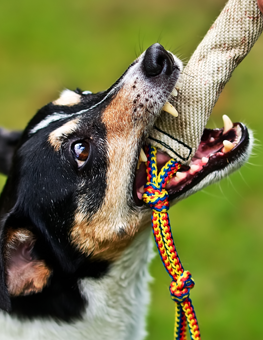Introducing a Second Dog Into Your Home
With a little effort and the right preparation, adding a new best friend to your pack can be a rewarding experience for you and your original dog.
Dogs make wonderful companions for both humans and pets, so it’s no wonder you’re thinking about bringing another dog into your home. Before you do, there are some important things to consider.
Twice the fun but also twice the responsibility, adopting a second dog is a decision that shouldn’t be taken lightly. As much as you want your dogs to be best buddies, getting there can be challenging. But with a little preparation and planning, you can help your dogs become BFFs in no time.
Choosing the Right Companion

For dogs with high energy levels and confidence, a playful puppy or young companion is likely the best match.
Every dog has its own unique play style, energy level and socialization needs. As your pet’s matchmaker, you’ll want to consider your current dog’s personality in the search for a canine candidate.
For dogs with high energy levels and confidence, a playful puppy or young companion is likely the best match. Low-energy and senior dogs are usually best suited for a dog that plays less, naps more and doesn’t get overexcited.
While your pet’s age, sex, breed and size are important things to consider, finding a match for your dog’s personality matters even more.
Creating the Right Environment
Preparing your home – and your pet – ahead of time can help set the tone for a successful meet-and-greet. Here’s what you can do before your pet arrives to make everyone happier and more comfortable.
- Dog toys and dog chews can create problems in possessive dogs when a new pet is added to the mix. So before your pets meet, make sure they’re put away to minimize the potential for aggression. They can always be reintroduced later after things settle down.
- Separate your dogs at mealtime for the first few days or weeks using a baby gate or different rooms. When one or both of their mealtimes are over, remove their food bowls immediately.
- Train your current dog out of any bad behavior before you consider adoption. Not only are bad habits contagious, and often picked up by a new pet, they can make introductions a lot riskier. Ideally, you’ll want your pet to be a role model for good behavior to your new dog.
Introducing Your New Dog
Getting a second dog can be exciting for pet owners, but it’s best to take your time with the introduction process. Instead of bringing them home immediately from the shelter, rescue, breeder or pet store, a gradual introduction is generally better.
- Meet in a neutral space neither dog is familiar with, preferably one that is fully fenced and outdoors. Using a leash, let both dogs get in close proximity, allowing them to see each other without interacting.
-

Adopting a second dog is a decision that shouldn’t be taken lightly.
Walk dogs parallel to each other in the same direction, but far enough apart so they can’t get into the other dog’s space. After a few minutes, change places with the other handler and walk back in the same direction you came from. This lets them get familiar with the other dog’s scent and markings.
- Watch for positive signs that your dogs are ready to meet, like tail wagging or a more relaxed demeanor. Once both dogs appear ready, begin walking them closer to each other in the same direction to see how they’ll react, being careful to avoid a face-to-face meeting.
- Let your dogs interact by dropping leashes when you feel comfortable with each dog’s behavior and body language. This allows them to sniff each other, initiate play, and connect at the canine level. If any signs of aggression occur, separate them immediately. Otherwise, finish up the meet-and-greet with a short walk.
- Bring the new dog home alone so they can investigate, being sure to hide any food bowls or toys first. After letting the new dog roam for a while, move it to a large space away from the door, and bring your resident dog home to meet their new friend on their shared turf.
Even if the introductions went smoothly, there’s still more work to be done. Bringing a second dog into your home and having them be a perfect fit for your current pet won’t happen overnight. It could take months for the two to build a relationship and develop a lifelong bond. But by following these steps, your efforts should be well-rewarded.


















